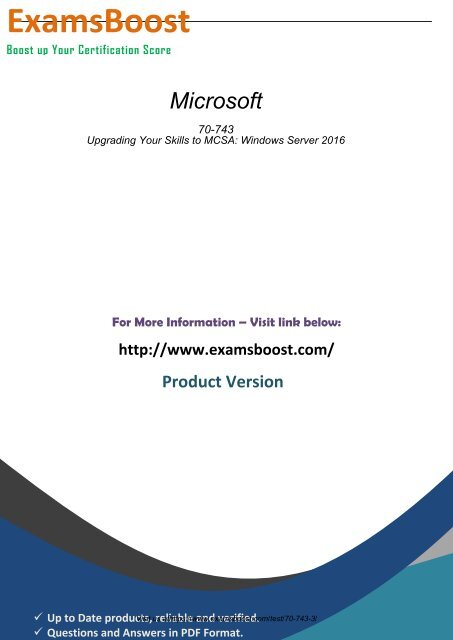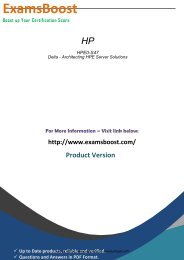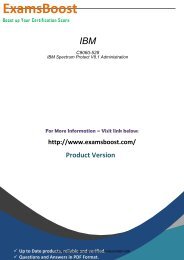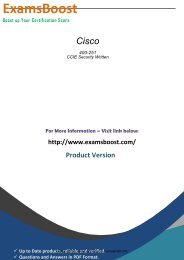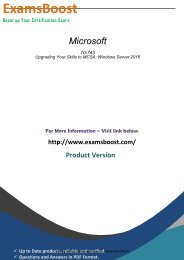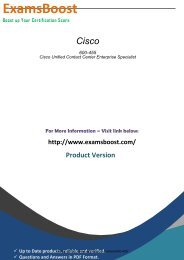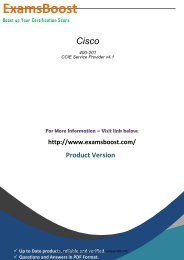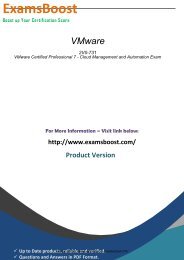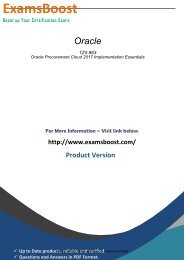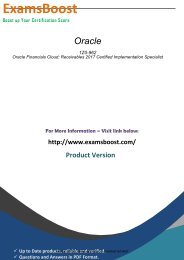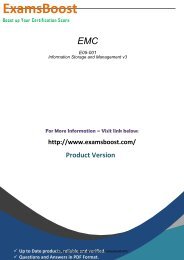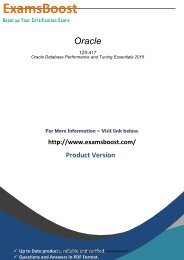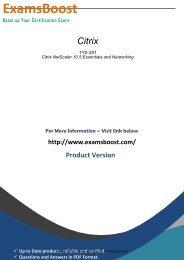70-743 Exam Certification
Study kits and preparation materials provided by us for 70-743 Test are authorized by the professionals and industry experts. You can easily pass your certification test with our brain dumps and PDF sample questions. For more info please visit here: http://www.examsboost.com/test/70-743/
Study kits and preparation materials provided by us for 70-743 Test are authorized by the professionals and industry experts. You can easily pass your certification test with our brain dumps and PDF sample questions. For more info please visit here: http://www.examsboost.com/test/70-743/
Create successful ePaper yourself
Turn your PDF publications into a flip-book with our unique Google optimized e-Paper software.
<strong>Exam</strong>sBoost<br />
Boost up Your <strong>Certification</strong> Score<br />
Microsoft<br />
<strong>70</strong>-<strong>743</strong><br />
Upgrading Your Skills to MCSA: Windows Server 2016<br />
For More Information – Visit link below:<br />
http://www.examsboost.com/<br />
Product Version<br />
Up to Date products, reliable and verified.<br />
Questions and Answers in PDF Format.<br />
Visit us athttps://www.examsboost.com/test/<strong>70</strong>-<strong>743</strong>-3/
Question: 1<br />
Note: This question is part of a series of questions that present the same scenario. Each question in the<br />
series contains a unique solution that might meet the stated goals. Some questions sets might have<br />
more than one correct solutions, while others might not have a correct solution.<br />
After you answer a question in this section, you will NOT be able to return to it. As a result, these<br />
questions will not appear in the review screen.<br />
Your network contains an Active Directory forest named contoso.com. The forest contains a member<br />
server named Server1 that runs Windows Server 2016. All domain controllers run Windows Server 2012<br />
R2.<br />
Contoso.com has the following configuration:<br />
You plan to deploy an Active Directory Federation Services (AD FS) farm on Server1 and to configure<br />
device registration.<br />
You need to configure Active Directory to support the planned deployment.<br />
Solution: You upgrade a domain controller to Windows Server 2016.<br />
Does this meet the goal?<br />
A. Yes<br />
B. No<br />
Answer: B<br />
Explanation:<br />
Device registration requires a forest functional level of Windows Server 2012 R2.<br />
References:<br />
https://technet.microsoft.com/en-us/windows-server-docs/identity/ad-fs/deployment/configure-afederation-server-with-device-registration-service<br />
https://technet.microsoft.com/en-us/windows-server-docs/identity/ad-fs/design/ad-fs-requirements<br />
Question: 2<br />
Note: This question is part of a series of questions that present the same scenario. Each question in the<br />
series contains a unique solution that might meet the stated goals. Some questions sets might have<br />
more than one correct solutions, while others might not have a correct solution.<br />
Visit us athttps://www.examsboost.com/test/<strong>70</strong>-<strong>743</strong>-3/
After you answer a question in this section, you will NOT be able to return to it. As a result, these<br />
questions will not appear in the review screen.<br />
Your network contains an Active Directory forest named contoso.com. The forest contains a member<br />
server named Server1 that runs Windows Server 2016. All domain controllers run Windows Server 2012<br />
R2.<br />
Contoso.com has the following configuration:<br />
You plan to deploy an Active Directory Federation Services (AD FS) farm on Server1 and to configure<br />
device registration.<br />
You need to configure Active Directory to support the planned deployment.<br />
Solution: You raise the forest functional level to Windows Server 2012 R2.<br />
Does this meet the goal?<br />
A. Yes<br />
B. No<br />
Answer: B<br />
Explanation:<br />
For a Windows Server 2012 R2 AD FS server, this solution would work. However, new installations of AD<br />
FS 2016 require the Active Directory 2016 schema (minimum version 85).<br />
References:<br />
https://technet.microsoft.com/en-us/windows-server-docs/identity/adfs/operations/configure-device-based-conditional-access-on-premises<br />
Question: 3<br />
Note: This question is part of a series of questions that present the same scenario. Each question in the<br />
series contains a unique solution that might meet the stated goals. Some questions sets might have<br />
more than one correct solutions, while others might not have a correct solution.<br />
After you answer a question in this section, you will NOT be able to return to it. As a result, these<br />
questions will not appear in the review screen.<br />
Your network contains an Active Directory forest named contoso.com. The forest contains a member<br />
server named Server1 that runs Windows Server 2016. All domain controllers run Windows Server 2012<br />
R2.<br />
Contoso.com has the following configuration:<br />
Visit us athttps://www.examsboost.com/test/<strong>70</strong>-<strong>743</strong>-3/
You plan to deploy an Active Directory Federation Services (AD FS) farm on Server1 and to configure<br />
device registration.<br />
You need to configure Active Directory to support the planned deployment.<br />
Solution: You run adprep.exe from the Windows Server 2016 installation media.<br />
Does this meet the goal?<br />
A. Yes<br />
B. No<br />
Answer: B<br />
Explanation:<br />
Device registration requires a forest functional level of Windows Server 2012 R2.<br />
New installations of AD FS 2016 require the Active Directory 2016 schema (minimum version 85).<br />
References:<br />
https://technet.microsoft.com/en-us/library/dd464018(v=ws.10).aspx<br />
https://technet.microsoft.com/en-us/windows-server-docs/identity/ad-fs/operations/configure-devicebased-conditional-access-on-premises<br />
Question: 4<br />
Note: This question is part of a series of questions that present the same scenario. Each question in the<br />
series contains a unique solution. Determine whether the solution meets the stated goals.<br />
Your network contains an Active Directory domain named contoso.com. The domain contains a DNS<br />
server named Server1. All client computers run Windows 10.<br />
On Server1, you have the following zone configuration.<br />
Visit us athttps://www.examsboost.com/test/<strong>70</strong>-<strong>743</strong>-3/
You need to ensure that all of the client computers in the domain perform DNSSEC validation for the<br />
fabrikam.com namespace.<br />
Solution: From Windows PowerShell on Server1, you run the Add-DnsServertrustAnchor cmdlet.<br />
Does this meet the goal?<br />
A. Yes<br />
B. No<br />
Answer: B<br />
Explanation:<br />
The Add-DnsServerTrustAnchor command adds a trust anchor to a DNS server. A trust anchor (or trust<br />
“point”) is a public cryptographic key for a signed zone. Trust anchors must be configured on every nonauthoritative<br />
DNS server that will attempt to validate DNS data. Trust Anchors have no direct relation to<br />
DSSEC validation.<br />
References:<br />
https://technet.microsoft.com/en-us/library/jj649932.aspx<br />
https://technet.microsoft.com/en-us/library/dn593672(v=ws.11).aspx<br />
Question: 5<br />
Note: This question is part of a series of questions that present the same scenario. Each question in the<br />
series contains a unique solution. Determine whether the solution meets the stated goals.<br />
Your network contains an Active Directory domain named contoso.com. The domain contains a DNS<br />
server named Server1. All client computers run Windows 10.<br />
On Server1, you have the following zone configuration.<br />
Visit us athttps://www.examsboost.com/test/<strong>70</strong>-<strong>743</strong>-3/
You need to ensure that all of the client computers in the domain perform DNSSEC validation for the<br />
fabrikam.com namespace.<br />
Solution: From a Group Policy object (GPO) in the domain, you add a rule to the Name Resolution Policy<br />
Table (NRPT).<br />
Does this meet the goal?<br />
A. Yes<br />
B. No<br />
Answer: A<br />
Explanation:<br />
The NRPT stores configurations and settings that are used to deploy DNS Security Extensions (DNSSEC),<br />
and also stores information related to DirectAccess, a remote access technology.<br />
Note: The Name Resolution Policy Table (NRPT) is a new feature available in Windows Server 2008 R2.<br />
The NRPT is a table that contains rules you can configure to specify DNS settings or special behavior for<br />
names or namespaces. When performing DNS name resolution, the DNS Client service checks the NRPT<br />
before sending a DNS query. If a DNS query or response matches an entry in the NRPT, it is handled<br />
according to settings in the policy. Queries and responses that do not match an NRPT entry are<br />
processed normally.<br />
References: https://technet.microsoft.com/en-us/library/ee649207(v=ws.10).aspx<br />
Question: 6<br />
Note: This question is part of a series of questions that present the same scenario. Each question in the<br />
series contains a unique solution. Determine whether the solution meets the stated goals.<br />
Your network contains an Active Directory domain named contoso.com. The domain contains a DNS<br />
server named Server1. All client computers run Windows 10.<br />
On Server1, you have the following zone configuration.<br />
Visit us athttps://www.examsboost.com/test/<strong>70</strong>-<strong>743</strong>-3/
You need to ensure that all of the client computers in the domain perform DNSSEC validation for the<br />
fabrikam.com namespace.<br />
Solution: From a Group Policy object (GPO) in the domain, you modify the Network List Manager<br />
Policies.<br />
Does this meet the goal?<br />
A. Yes<br />
B. No<br />
Answer: B<br />
Explanation:<br />
Network List Manager Policies are security settings that you can use to configure different aspects of<br />
how networks are listed and displayed on one computer or on many computers.<br />
Network List Manager Policies are not related to DNSSEC.<br />
References: https://technet.microsoft.com/en-us/library/jj966256(v=ws.11).aspx<br />
Question: 7<br />
You have a server named Server1 that runs Windows Server 2016.<br />
You need to configure Server1 as a multitenant RAS Gateway.<br />
What should you install on Server1?<br />
A. the Network Controller server role<br />
B. the Remote Access server role<br />
C. the Data Center Bridging feature<br />
D. the Network Policy and Access Services server role<br />
Answer: B<br />
Explanation:<br />
RAS Gateway - Multitenant. You can deploy RAS Gateway as a multitenant, software-based edge<br />
gateway and router when you are using Hyper-V Network Virtualization or you have VM networks<br />
deployed with virtual Local Area Networks (VLANs). With the RAS Gateway, CloudService Providers<br />
Visit us athttps://www.examsboost.com/test/<strong>70</strong>-<strong>743</strong>-3/
(CSPs) and Enterprises can enable datacenter and cloud network traffic routing between virtual and<br />
physical networks, including the Internet. With the RAS Gateway, your tenants can use point-so-site VPN<br />
connections to access their VM network resources in the datacenter from anywhere. You can also<br />
provide tenants with site-to-site VPN connections between their remote sites and your CSP datacenter.<br />
In addition, you can configure the RAS Gateway with BGP for dynamic routing, and you can enable<br />
Network Address Translation (NAT) to provide Internet access for VMs on VM networks.<br />
References:<br />
https://technet.microsoft.com/en-us/windows-server-docs/networking/remote-access/remote-access<br />
Question: 8<br />
HOTSPOT<br />
You have a server named Server1 that runs Windows Server 2016. Server1 is a Hyper-V host.<br />
You have two network adapter cards on Server1 that are Remote Direct Memory Access (RDMA)-<br />
capable.<br />
You need to aggregate the bandwidth of the network adapter cards for a virtual machine on Server1.<br />
The solution must ensure that the virtual machine can use the RDMA capabilities of the network adapter<br />
cards.<br />
Which commands should you run first? To answer, select the appropriate options in the answer area.<br />
Answer:<br />
A new feature of Windows Server 2016 is SET (Switch Embedded Teaming).<br />
Create a SET team<br />
You must create a SET team at the same time that you create the Hyper-V Virtual Switch with the New-<br />
VMSwitch Windows PowerShell command.<br />
When you create the Hyper-V Virtual Switch, you must include the new EnableEmbeddedTeaming<br />
parameter in your command syntax.<br />
Visit us athttps://www.examsboost.com/test/<strong>70</strong>-<strong>743</strong>-3/
In the following example, a Hyper-V switch named TeamedvSwitch with embedded teaming and two<br />
initial team members is created.<br />
New-VMSwitch -Name TeamedvSwitch -NetAdapterName "NIC 1","NIC 2"<br />
-EnableEmbeddedTeaming $true<br />
References:<br />
https://technet.microsoft.com/en-gb/library/mt403349.aspx<br />
Question: 9<br />
DRAG DROP<br />
You have a server named Server1 that runs Windows Server 2016.<br />
You need to deploy the first cluster node of a Network Controller cluster.<br />
Which four cmdlets should you run in sequence? To answer, move the appropriate cmdlets from the list<br />
of cmdlets to the answer area and arrange them in the correct order.<br />
Answer:<br />
Deploy Network Controller using Windows PowerShell<br />
Step 1: Install-WindowsFeature<br />
Install the Network Controller server role<br />
To install Network Controller by using Windows PowerShell, type the following commands at a Windows<br />
PowerShell prompt, and then press ENTER.<br />
Visit us athttps://www.examsboost.com/test/<strong>70</strong>-<strong>743</strong>-3/
Install-WindowsFeature -Name NetworkController –IncludeManagementTools<br />
Step 2: New-NetworkControllerNodeObject<br />
You can create a Network Controller cluster by creating a node object andthen configuring the cluster.<br />
You need to create a node object for each computer or VM that is a member of the Network Controller<br />
cluster.<br />
Tocreate a node object, type the following command at the Windows PowerShell command prompt,<br />
and then press ENTER. Ensure that you add values for each parameter that are appropriate for your<br />
deployment.<br />
New-NetworkControllerNodeObject –Name -Server -FaultDomain -RestInte<br />
Step 3: Install-NetworkControllerCluster<br />
To configure the cluster, typethe following command at the Windows PowerShell command prompt,<br />
and then press ENTER. Ensure that you add values for each parameter that are appropriate for your<br />
deployment.<br />
Install-NetworkControllerCluster –Node –ClusterAuthentication …<br />
Step 4: Install-NetworkController<br />
To configure the Network Controller application, type the following command at the Windows<br />
PowerShell command prompt, and then press ENTER. Ensure that you add values for each parameter<br />
that are appropriate for your deployment.<br />
Install-NetworkController –Node –ClientAuthentication<br />
References: https://technet.microsoft.com/en-us/library/mt282165.aspx<br />
Question: 10<br />
You have an Active Directory domain that contains several Hyper-V hosts that run Windows Server 2016.<br />
You plan to deploy network virtualization and to centrally manage Datacenter Firewall policies.<br />
Which component must you install for the planned deployment?<br />
A. the Routing role service<br />
B. the Canary Network Diagnostics feature<br />
C. the Network Controller server role<br />
D. the Data Center Bridging feature<br />
Answer: C<br />
Explanation:<br />
Using Windows PowerShell, the REST API, or a management application, you can use Network Controller<br />
to manage the following physical and virtual network infrastructure:<br />
References: https://technet.microsoft.com/en-us/library/dn859239.aspx<br />
Question: 11<br />
You have a virtual machine named VM1 that runs Windows Server 2016. VM1 hosts a service that<br />
requires high network throughput.<br />
Visit us athttps://www.examsboost.com/test/<strong>70</strong>-<strong>743</strong>-3/
VM1 has a virtual network adapter that connects to a Hyper-V switch named vSwitch1. vSwitch1 has one<br />
network adapter. The network adapter supports Remote Direct Memory Access (RMDA), the Single Root<br />
I/O Virtualization (SR-IOV) interface, Quality of Service (QoS), and Receive Side Scaling (RSS).<br />
You need to ensure that the traffic from VM1 can be processed by multiple networking processors.<br />
Which Windows PowerShell command should you run on the host of VM1?<br />
A. Set-NetAdapterRss<br />
B. Set-NetAdapterRdma<br />
C. Set-NetAdapterSriov<br />
D. Set-NetAdapterQoS<br />
Answer: A<br />
Explanation:<br />
The Set-NetAdapterRss cmdlet sets the receive side scaling (RSS) properties on a network adapter. RSS is<br />
a scalability technology that distributes the receive network traffic among multiple processors by<br />
hashing the header of the incoming packet. Without RSS Windows Server 2012/2016; network traffic is<br />
received on the first processor which can quickly reach full utilization limiting receive network<br />
throughput. Many properties can be configured using the parameters to optimize the performance of<br />
RSS. The selection of the processors to use for RSS is an important aspect of load balancing. Most of the<br />
parameters for this cmdlet help to determine the processors used by RSS.<br />
Question: 12<br />
You have a server named Server1 that runs Windows Server 2016. Server1 is a Hyper-V host that hosts a<br />
virtual machine named VM1.<br />
Server1 has three network adapter cards that are connected to virtual switches named vSwitch1,<br />
vSwitch2 and vSwitch3.<br />
You configure NIC Teaming on VM1 as shown in the exhibit. (Click the Exhibit button.)<br />
Visit us athttps://www.examsboost.com/test/<strong>70</strong>-<strong>743</strong>-3/
You need to ensure that VM1 will retain access to the network if a physical network adapter card fails on<br />
Server1.<br />
What should you do?<br />
A. From Hyper-V Manager on Server1, modify the settings of VM1.<br />
B. From Windows PowerShell on VM1, run theSet-VmNetworkAdapterTeamMapping cmdlet.<br />
C. From Windows PowerShell on Server1, run the Set-VmNetworkAdapterFailoverConfiguration cmdlet.<br />
D. From Windows PowerShell on Server1, run the Set-VmSwitch cmdlet.<br />
Explanation:<br />
Answer: A<br />
Visit us athttps://www.examsboost.com/test/<strong>70</strong>-<strong>743</strong>-3/
You can configure NIC teaming in the Guest OS; however, before NIC teaming will work in a virtual<br />
machine, you need to enable NIC teaming in the Advanced Features section of the VM settings.<br />
Question: 13<br />
HOTSPOT<br />
You have an Active Directory domain named Contoso.com. The domain contains Hyper-V hosts named<br />
Server1 and Server2 that run Windows Server 2016. The Hyper-V hosts are configured to use NVGRE for<br />
network virtualization.<br />
You have six virtual machines that are connected to an external switch. The virtual machines are<br />
configured as shown.<br />
To which virtual machine or virtual machines can VM1 and VM3 connect? To answer, select the<br />
appropriate options in the answer area.<br />
Answer:<br />
Visit us athttps://www.examsboost.com/test/<strong>70</strong>-<strong>743</strong>-3/
The GRE keys must match.<br />
To separate the traffic between the two virtualized networks, the GRE headers on the tunneled packets<br />
include a GRE Key that provides a unique Virtual Subnet ID for each virtualized network.<br />
References:<br />
https://blogs.technet.microsoft.com/keithmayer/2012/10/08/step-by-step-hyper-v-networkvirtualization-31-days-of-favorite-features-in-winserv-2012-part-8-of-31/<br />
Question: 14<br />
You have a Nano Server named Nano1.<br />
You deploy several containers to Nano1 that use an image named Image1.<br />
You need to deploy a new container to Nano1 that uses Image1.<br />
What should you run?<br />
A. the Install-WindowsFeature cmdlet<br />
B. the docker run command<br />
C. the docker load command<br />
D. the Install-NanoServerPackage cmdlet<br />
Answer: B<br />
Explanation:<br />
When an operator executes docker run, the container process that runs is isolated in that it has its own<br />
file system, its own networking, and its own isolated process tree separate from the host.<br />
The basic docker run command takes this form:<br />
$ docker run [OPTIONS] IMAGE[:TAG|@DIGEST] [COMMAND] [ARG...]<br />
Visit us athttps://www.examsboost.com/test/<strong>70</strong>-<strong>743</strong>-3/
Powered by TCPDF (www.tcpdf.org)<br />
Thank You for Trying Our Product<br />
For More Information – Visit link below:<br />
http://www.examsboost.com/<br />
FEATURES<br />
90 Days Free Updates<br />
Money Back Pass Guarantee<br />
Instant Download or Email Attachment<br />
24/7 Live Chat Support<br />
PDF file could be used at any Platform<br />
50,000 Happy Customer<br />
WE ACCEPT<br />
Visit us athttps://www.examsboost.com/test/<strong>70</strong>-<strong>743</strong>-3/


